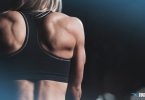My shoulders and I have a challenging relationship.
We’ve been through numerous separations. This led to two sessions of counseling to help us serve the other better and maintain a closer relationship without the attachment issues we’ve had in the past.
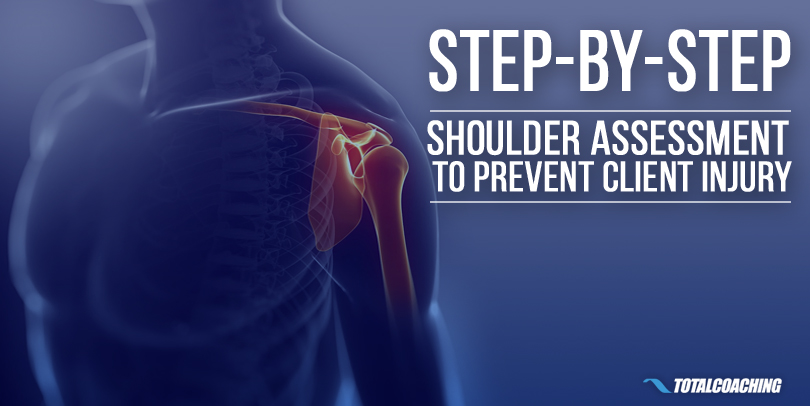
I believe, in the medical world, this is known as multiple shoulder dislocations and repeated surgery.
I admit it. It was my fault. I’ve abused my shoulders with a cocktail of rugby, regularly being the smallest guy on the pitch, and for some time, a lack of knowledge about how to care for them. Maybe the hypermobility didn’t help, so they have to take some responsibility for our predicament too!
It’s safe to say I’ve done my fair share of rehab. And, as a professional strength and conditioning coach, I've also screened hundreds of athletes in a wide variety of sports.
Personally, I train in calisthenics which puts a demand and intensity on my shoulders matched by few other sports or activities. As a result, I’ve learned a lot about these very complicated joints and why they need special attention for me, for you, and for your clients.
About the Shoulder
The shoulder is impressive, but it requires special care!
The shoulder is the most mobile joint in the human body, but this great capacity for movement comes at the cost of stability.
Most people will know that the shoulder is a ball and socket joint, and it is this architecture that gives it the range of movement. The hip is the same type of joint, but you rarely meet someone who has dislocated their hip unless they're someone who is eligible for a free bus pass.
Or, you have met me. Thanks to my hypermobility, I’ve dislocated that joint too!
But for most people, the hip is securely packed into a deep socket and surrounded by thick ligaments and an arsenal of large, strong muscles to support it.
The shoulder, on the other hand, is different. The head of the bone in the upper arm (humerus) articulates with the glenoid fossa on the scapular. Together they become the glenohumeral joint.
#Anatomy of the #Shoulder #Joint_Capsule https://t.co/DTT8TgRoGW #mendmeshop pic.twitter.com/z77NWe8ztm
— MendMeShop (@MendMeShop) July 4, 2016
The mobility-stability relationship arises because the glenoid fossa is very shallow, like a saucer, as you can see in the image below. Therefore, the humeral head has plenty of freedom to move, but there is not much to stop it from migrating into dysfunctional positions or slipping out the edge of the confines of the saucer.

Dysfunction in and around the shoulder can cause faulty joint arthrokinematics, leaving it susceptible to impingement, pain, instability, and trauma. Many people will deal with shoulder issues due to poor posture, repetitive stress, poorly structured training programmes and previous injury.
Shoulder dysfunction is extremely common today due to our lifestyles. And because of its susceptibility to injury, we need to know how to assess and programme accordingly, keeping it safe and functioning well.
Assessing the Shoulder
In most training programmes, it is likely you will intend on doing some form of upper body training; therefore, we need to know whether it is safe to load the shoulder joint, at what intensity, and if we need to do any corrective training first.
So my headline priority from the screening and assessment process is to understand two things: how the shoulders behave in an integrated, full-body movement and what they do in more isolated actions. From that, I can understand what musculature and structures are likely over and underactive, enabling me to put specific exercises in the programme to address the client's individual issues.
Integrated Movement Screening
My go-to screening tool here is the overhead squat without the use of a dowel or very light bar.
The reason for that is I’ve seen athletes over the years use it to crank up some tension in the upper body, helping them to stabilise and create a better body position. Take the bar out, and the shoulders are free to do as they please, giving me more information.
I recommend an integrated movement like the overhead squat because I want to see how the shoulders interact with the kinetic chain when other joints are moving at the same time. The body is smart and will find the path of least resistance, so shoulder health needs to be assessed in context with everything else.
Here’s an example: The muscle origin of the latissimus dorsi is on the ilium of the pelvis and inserts onto the anterior humerus, having made a connection with the spine and scapular along the way.
With the shoulders flexed and the hands overhead, the lats are in a lengthened state. In a contracted state, they extend the shoulder, internally rotate the humerus, and arch the lower back. Imagine being put in handcuffs.
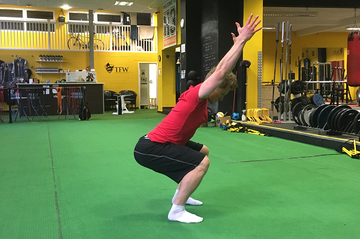
A textbook overhead squat
To set up the overhead squat, ask the client to raise their hands over their head, thumbs facing behind them (external shoulder rotation) and get the biceps inline with the ears.
If movement is optimal, they should be able to do this in a standing position without losing control of the spine and arching the back or lifting the rib cage.
The next stage is to see if the client can maintain that alignment when they go into the squat movement.
As the overhead squat is initiated, other forces begin to act on the pelvis that may place an additional demand on the lats. The brain is trying to complete the squat movement, and if it can’t do it whilst maintaining optimal joint position, it will make adjustments to create more ‘space’ to play with.
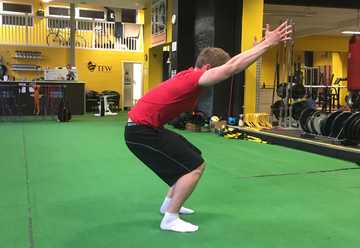
Overhead squat with posterior tilt
For example, if the hamstrings are tight and can’t lengthen sufficiently to maintain a normal spine position, the pelvis will tuck underneath (posterior tilt) and create a pull on the lats. The result is that the arms may fall forward.
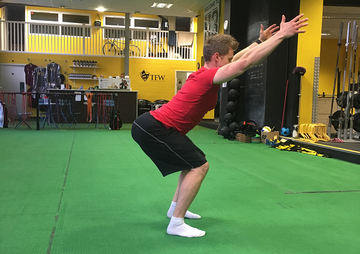
Overhead squat with anterior tilt
Alternatively, if the lats are short, trying to keep them overhead might lead to an anterior tilt or an arching in the lower back. The limitation in range of movement is compensated for by the ilium moving closer to the shoulders.
Because the lats connect the shoulder to the pelvis, the overhead squat enables us to easily identify how the shoulder is affected as part of the global movement pattern.
Its interaction with the other joints involved (ankle, knee, hip) helps us to build a top level picture as to whether there is a shoulder issue or if something else is the root of a movement compensation.
We are effectively asking why there is a movement compensation at the shoulder, not just what the movement compensation is.
Using the above example, you could be hammering away at shoulder range of movement when fixing the hamstrings might solve the problem.
I’ve focused on lat overactivity to illustrate a point, but the other main musculatures to be aware of that could affect shoulder health and range of movement are the pectorals and posterior cuff.
Isolated Movement Assessment
Based on the results of the global movement assessment, we can drill down to the details. Here are a few tests that might add some depth to the picture:
1. Wall Elevation Test
What is being assessed: Lat length
Method: Client stands with feet together against a wall, with their knees in a quarter squat position. They are instructed to take the hands overhead and touch their thumbs against the wall.
What to look for: Can the client get their thumbs to the wall whilst maintaining a normal curve in the spine? If the thumbs don’t touch the wall, the lower back arches, or the rib cage excessively elevates, there may be limitations in lat length.
2. Supine Internal Rotation
What is being assessed: Length of posterior structures (combination of posterior cuff length, teres minor and infraspinatus, and restrictions in the posterior capsule).
Method: With the client lying flat and supine, move the elbow to a position at 90 degrees to the body. Place your hand on the shoulder to stabilize the glenhumural joint and prevent protraction of the shoulder blade.
Instruct them to try and take their hand as close to the floor/bench as they can (internal rotation). Measure the angle of the forearm in relation to the starting point (vertical forearm) with a goniometer.
What to look for: Clients should be able to achieve more than 70 degrees of internal rotation.
3. Supine External Rotation
What is being assessed: Pec length (primarily pec major)
Method: With the client lying flat and supine, move the elbow to a position at 90 degrees to the body. Stabilise the glenohumeral joint with your hand and ask them to try and touch the floor/bench with the back of the hand without extending the wrist. Measure the angle of the forearm in relation to the starting point (vertical forearm) a goniometer.
What to look for: Clients should be able to achieve at least 90 degrees of external rotation. Performing this test on a bench is therefore beneficial if ranges are in excess of this.
Using #hangs as an assessment and practice of #external #rotation: https://t.co/VJQdvI1CRQ #shoulder #control #rehab pic.twitter.com/Cc5bTGbo1p
— Christine Ruffolo (@ruffolous) May 22, 2016
Analyzing the Findings
These tests are pretty simple and will help you build a picture of the health of the shoulder and it’s readiness for training. Getting a picture of the global movement pattern, and then using a process of elimination using the isolated movements, will help you to be more specific with your programming.
If clients do not perform well in any of the tests, I recommend you incorporate specific corrective exercises into the training programme as a priority.
Concluding Tips
To wrap this up I’m going to offer 3 quick take-home messages tips based on what I have experienced and learnt:
Tip #1: Use self-massage and mobility techniques regularly to improve range of movement in restricted tissues or structures.
Tip #2 Everyone needs to do posterior shoulder strengthening. Our lifestyles mean we spend a lot of time in protracted positions. Getting healthy shoulders is about creating balanced range of movement and strength from front to back. So, strengthen the mid/low traps, rhomboids, and external rotators.
Tip #3: In my own experiment (n=1), I have found an incomparable benefit of training the shoulder more holistically through calisthenics movements for a number of reasons. Maximal grip exercises activate the shoulder stabilizers.
Performing strength-based movements that contain a maximal grip component then works the prime movers. Exercises that require you to hang (pull ups, active hang, leg raises, skin the cat, rows, etc.) do all this at the same time.
I am confident that the shoulder should be trained as an integrated unit where stability and strength are used concurrently and not as independent functions. Standard training methods, resistance machines, and a lot of rehab-style exercises do not incorporate both components.
The result of my experiment is following multiple dislocations and surgeries I can do a human flag. In this move, the arm is overhead and externally rotated which is the exact position I used to dislocate in. It is also under huge stability and strength strain.
Screening and assessing clients adds a huge amount of value to the service you offer, the program you write, and the results your clients get.
Having done all the TheraBand exercises in the book, the only thing that has made my shoulders bombproof in recent years is calisthenics. I’m happy to report my shoulders and I are now closer than we’ve ever been, both figuratively and literally.
If you want to explore how you can use calisthenics to give your clients a new stimulus, and train the shoulders in a fun and engaging way, check out our FREE Beginner's Guide to Calisthenics or check out our website at http://www.schoolofcalisthenics.com.

